Executive summary
The report analyses Texas Roadhouse Inc. with the aim of defining its strategic management model. Through SWOT analysis, the strengths, weaknesses, opportunities, and threats of the company are established.
Several strategic management tools like the SWOT matrix, internal evaluation matrix, EFE matrix, IE matrix, SPACE matrix, Grand matrix, BCG, CPM, and the QSPM have been applied on the analysis of the Texas Roadhouse restaurants.
From the analysis it emerges that the company has a competitive advantage held on its products and the product price. It is also found that Texas Roadhouse Inc. has the capabilities and capacity of using its opportunities to deal with the threats exposed by the external environment. This can encourage further market penetration.
Basically, the product of the company has been the major reason why the company has remained competitive because it is unique. The internal factors evaluation matrix and the external factors evaluation have been recommended as the most appropriate strategic management tools as they will help the company grow.
Outline
Executive summary
Texas Roadhouse existing mission, vision, objectives and strategies
Developed mission and vision statement for the organization
Texas Roadhouse external opportunities and threats competitive profile matrix (CPM) external factor evaluation matrix (EFE)
Texas Roadhouse internal strengths and weaknesses.
Other Matrices
- Internal evaluation matrix (IFE)
- SWOT Matrix
- Strategic position and action evaluation (SPACE) Matrix
- Boston consulting Group (BCG) Matrix
- Internal external matrix (IE)
- Grand Strategy Matrix
- Quantitative strategy planning matrix (QSPM)
Advantages and disadvantages of alternative strategies
Financial ratios
Specific strategies and long-term objectives
Specific annual objectives and policies
Procedures for strategy review and evaluation
Projected financial statement
Analysis of a company (Strategic Management Model)
Texas Roadhouse restaurants existing mission, vision, objectives and strategies
The mission of Texas Roadhouse is “Legendary Food, Legendary Service” (Texas Roadhouse, 2011) meaning that the company is there to stay through the provision of quality food to both the local and the international markets.
It also means that the food and the services offered by the Texas Roadhouse restaurant are classic and legendary.
The following are the objectives of the Texas Roadhouse;
- To provide high quality meals which are offered through friendly service
- To ensure that the customers are serviced with high quality and fresh food
- Use moderate prices for both food and drinks with the aim of attracting customers
- To increase sales as well as maintaining profits from the sales in the different existing restaurants
- To start new restaurants successfully and acquire others through franchising
- To expand their business both domestically and internationally so as to increase their market share.
- Provide a more relaxed atmosphere for its customers by creating a fun and relaxing atmosphere.
- To maximize sales all the year round as well as retaining the market share.
- Offer food and beverage prices that are affordable by all customers across a wider range of customers’ spectrum.
Strategies applied
The Texas Roadhouse has designed an operating strategy that would position each it is different restaurants as the domestic destination for the different segmented rage of consumers looking for meals of high quality and affordable as well as served in both attentive and friendly service (Texas Roadhouse, 2011).
The operating strategy is based on a number of concepts that have enabled the fast and sustainable growth of the Texas Roadhouse restaurants. These key operative key components are;
Offer of high quality and freshly prepared meals (Texas Roadhouse, 2011), to the different chain of customers. The company places great deal in ensuring that all the customers are able to acquire high quality and freshly made food all the time. This is achieved through the hand cutting of the steaks and preparing them in a customer satisfying manner.
Throughout the restaurants’, Texas Roadhouse has developed unique recipes to ensure consistency in the food quality as well as their taste (Texas Roadhouse, 2011). To ensure that the food is of high quality, the management team inspects all the entrees before they are presented to the customer to ensure that the customers’ orders are matched.
The order is also checked to confirm that that the expected standards are met of high quality, appearance as well as its presentation. On top of this, the management has been able to employ a product team coaches who provide continued training to kitchen staff. The education and the training of the kitchen staff is geared towards uniformity in recipes, portion size, food appearance, food safety standards, and the preparation procedures (Texas Roadhouse, 2011).
The company offers a manager compensation which is performance based (Texas Roadhouse, 2011). The supervisors and managers who are also referred to as managing partners and market partners are compensated on performance based index.
To ensure that the partners are well compensated, each partner is paid a particular salary and performance bonuses which is based on the partners share in the pretax income. This is aimed at attracting highly motivated, talented, skilled, and experienced market and managing partners.
The company focuses on allocating most of its time on dinner. The operating hours are limited to dinner and the teams are offered a single shift on the weekdays to offer time for managing and preparing the dinner. This is geared towards the preparation of high quality meals with consistency to the different segmented loyal customers.
Through the focus on the dinner, the Texas Roadhouse has been able to attract and retain experienced management team. Lastly, the company focuses on the low ration table servers to ensure that their teams’ servers focus greatly on the different esteemed guests. The dinners are served on individualized levels to ensure that each client get what they have ordered.
Texas Roadhouse has been able to offer attractive price points to its different customers (Texas Roadhouse, 2011). The company has devised offers moderate prices levels to its beverages and food. The prices are sometimes even lower than competitors to attract a wider range of customers. Each of the meal has different price points aimed at attracting different customers with different income levels and make them satisfied by making them feel appreciated.
The expectations of all the customers are met in Texas roadhouse as well as by meeting their budgets. For example, steaks and checks have different prices with a difference in the weight of each steak. The restaurant has devised a per guest average check which is based on the number of sales divided by the guests numbers and offered at $14.63 (Texas Roadhouse, 2011).
Texas Roadhouse Inc has created a comfortable and fun atmosphere for its guests. The company believes in repeat business thus the need for comfortable atmosphere. For instance, the company has lodge décor which have different artifacts, rugs, Southwestern prints, neon signs, and hand painted murals (Texas Roadhouse, 2011). On top of these, the restaurants offer jukeboxes that usually play country music hits in a ceasing manner. It also offers in-house entertainment like birthday celebrations, and line dancing.
Developed mission and vision statement for the organization
Mission of the Texas Roadhouse restaurant could be “the provision of high quality foods, with friendly services” whilst the vision statement would be” to be the leading provider of highly quality foods in affordable food prices.”
Texas Roadhouse Restaurants’ external opportunities and threats
SWOT is an analysis framework that gives the strengths, weakness, opportunities and threats that an organisation faces in the market industry (Hill & Westbrook, 1997, p. 48).
According to Bohm (2009) SWOT analysis uses an integrated approach to confront internal strengths and weakness of a company as well as the external opportunities to the company and the threats it faces so as to come up with strategic options.
SWOT analysis is used by organisations for marketing and strategic planning processes (Kern 2001).
The following external threats and opportunities have been developed.
Competitive profile matrix (CPM)
A competitive profile matrix is a based on the analysis of the different competitors as well as their different strengths and weakness in respect to the strategic position of the firm or company in question (Torlak, & Sanal, 2007; Schultz & Kitchen, 2000).
For convenient purposes, the CPM will be based on the top competitors of Texas Road house restaurants in the region. The top competitors are McDonalds Corporation, Yum! Brands Inc.
Following success factors will be put into the considerations during the construction of the CPM and they are advertising, product quality, price, competitiveness, management, financial position, market position, customer loyalty, global expansion, and market share
The ratings range from 1 to 4 where 1 represents poor representation, 2 is average, 3 above average, and 4 superior. The weighted score is applied through the multiplication of the weight and factor ratings. Lastly, the total weighted score should range from 1.0 to 4.0 where 1.0 is the lower range and the 4.0 the higher range.
For CPM matrix an average is estimated at 2.5 and below 2.5 is considered as weak one. The firm with the highest weighted score is regarded as the winner among the different competitors
Based on the CPM matrix Macdonald Corporation has the highest level of score compared to the other two. Texas Roadhouse emerges as the second with a score of 3.65 which implies that its standing is above average.
This means that it’s strategic positioning in the market although it is below MacDonald’s but below the Yum Brands.
An external factor evaluation matrix (EFE)
EFE matrix is an assessment carried to determine external factors through the use of the opportunities and threats faced by a company (Torlak, & Sanal, 2007).
It is based on the external factors evaluation like the technological, legal, political, social, cultural, demographics, economic, and competitive information among others (Kotler & Keller, 2006). The weighted score, weight, and the ratings are basically based on the same synopsis as in the CPM matrix
Based on the EFE matrix, the weighted score of the Texas Roadhouse restaurant is at 3.35 which is above the average of 2.5. This means that the company has the capabilities and capacity of using its opportunities to deal with the threats exposed by the external environment.
If also means that the company can favorably compete in the market although it has more threats than the opportunities. However, the opportunities have more weight compared to the weight of the threats.
Internal strengths and weaknesses
Internal strengths of the Texas Roadhouse restaurant have been formulated using the SWOT analysis tool.
Internal evaluation matrix (IFE)
IFE matrix is a tool used in strategic management to evaluate the weakness and the strengths of an organization (Torlak, & Sanal, 2007). Based on the point pointer scale, the IFE weights, rating and weighted scored are ranked the same as explained under the CPM matrix
The indication by the total weighted score of the Texas Roadhouse Restaurant is that implies that the company has the capabilities of turning the weaknesses from weaknesses to strengths. Since the score is above 2.5 which is the weighted average, the company is positioned better in the market.
SWOT Matrix
It evaluates the strengths, weaknesses, opportunities, and threats facing a company (Torlak, & Sanal, 2007)
Strategic position and action evaluation (SPACE) Matrix
SPACE is used to determine the strategic options that a company has for its operations (Joshi, 2005; Torlak, & Sanal, 2007). Table below shows the different strategies based on Texas Roadhouse restaurant which helps develop the SPACE matrix
SPACE Matrix
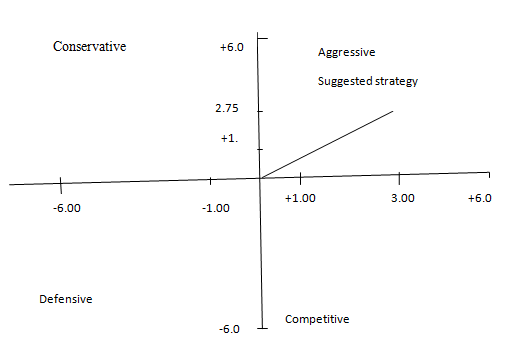
From the SPACE matrix above, Texas Roadhouse should pursue aggressive strategy since it has a strong competitive position in the hospitality industry. It can use its internal strengths to gain a huge market share.
Boston consulting Group (BCG) Matrix
It is a strategic Management tool which is based on product development and market penetration and relates to the different stages of product life cycle (Griffin, 2011). The matrix consists of the BCG question marks, dogs, stars, and the cash cows (Armstrong, 2006).
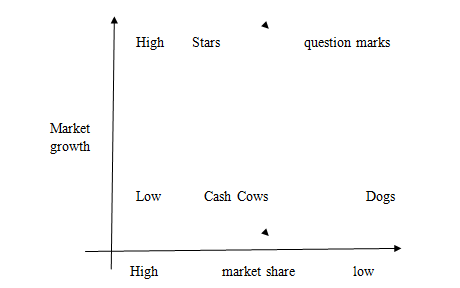
Stars represent high market growth and market share and when kept they lead to more cash. The question marks mean that the firm’s products are in a growing market although it has a low market share (Griffin, 2011). Have low returns since they are unfamiliar to the buyers.
The cash cows have low growth although they have a high market share. Through competitive advantage, cash cows lead to high profits. The dogs are products that exist in a low market growth as well as low market share (Porter, 1998).
For Texas Roadhouse, it can invest its stars, to boost its cash cows. It should avoid the BCG dogs as they can negatively impact the company and prioritize on its question marks and transform them to stars.
Internal external matrix (IE)
IE combines both the IFE and the EFE to aid in analyzing the strategic position and the working conditions of a business in an industry. Below is the Texas Roadhouse IE matrix.
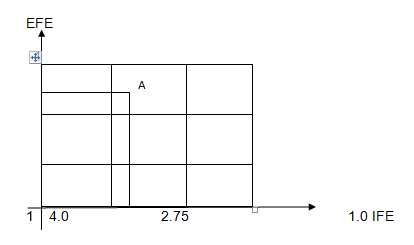
EFE = 3.35 and IFE 2.F meeting at point A which is a high level to grow and build. This means that Texas Roadhouse has to develop a growth and build strategy which requires aggressive and intensive strategies.
The adopted strategies could focus more on product development, market development, and market penetration. Operational perspectives should adopt strategies like horizontal and forward integration.
Grand Strategy Matrix
It gives alternatives of management strategies that can be adopted by an organization. It is basically based on four quadrants each with set of strategies (Torlak, & Sanal, 2007). Based on the matrix strategy matrix below, Texas Roadhouse falls under the first quadrant because it has a competitive advantage which can be used for expansion.
It also concentrates on a single product which can be used for further market penetration. Since the company has high resources it can concentrate on forward, backward, and horizontal expansion.
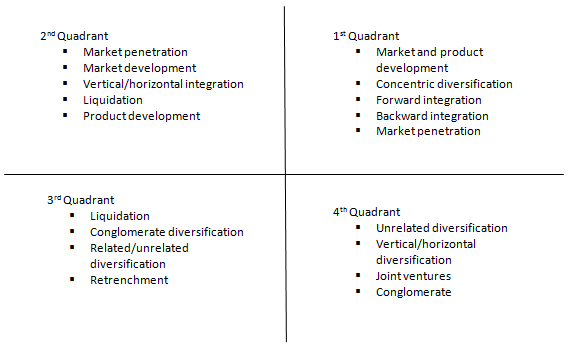
Quantitative strategy planning matrix (QSPM) for Texas Roadhouse
From the QSPM matrix above expanding the company internally would be appropriate as it has the highest score of 3.99 while the other option has a score of 2.90. Internal expansion could be adoption of information technology which has numerous benefits to an organization.
Advantages and Disadvantages of Alternative Strategies
Specific strategies and long-term objectives
Some of the recommendable strategies would be the adoption of the IFE and the EFE matrices. These strategic, management tools have the capacity of the company help in determining the internal and the external factors that would in directing the company’s direction.
The objectives of these strategies would help turn the threats into opportunities and weaknesses to opportunities. Other long term objective would be ensuring that it gains its organizational goals and objectives.
Financial ratios
All figures are in thousand dollars
Current Ratio = current Assets
Current liabilities
= 113,922/ 112,058 = 1.01
Since the current ratio is above one it means that Texas Roadhouse has no liquidity issue
Quick ratio = quick assets/current liabilities
= 113,922/112,729 = 1.01
Quick ratio = currents assets—inventories
= 113,922 – 1,193 = 112,729
Working capital = current Assets – current liabilities
= 113,922-112,058 = 1864
The working capital of Texas Roadhouse is not negative meaning that it has no financial pressure thus no foreseen financial difficulties.
Debt ratio = total Debt/total assets
= 52,180/ 702,801 = 0.074
Debt to equity ratio = total debt/total equity
= 52,180/ 499,382 = 0.10
Texas Roodhouse restaurant has a debt ratio and a debt equity ratio of less than one meaning that their debts cannot lead to the liquidation of the company equity.
Recommended specific annual objectives and policies
Following are the annual objectives and policies;
- Increase the market share of Texas Roadhouse by the end of the next financial year.
- Achieve the projected market cash sales of 10% in the next quarter.
- Expand the business internally through forward and vertical integration methods
Recommended procedures for strategy review and evaluation
Strategy review and evaluation will be carried on quarterly basis so as to explore whether the implemented strategies are in place. This will go only for one year until the implementation process is complete. The implementation costs of the strategies are projected to use five percent of the generated income.
However, in case the strategies seem inappropriate, contingency plan will be used to analyze the situation. After the first quarter, a cost benefit analysis will be carried. Other methods of financial evaluation will also be applied to review and evaluate the effectiveness of the chosen strategies
Projected financial statements
The projections are that the sales of the Texas Roadhouse restaurant will increase by 10% which will lead to a proportionate increase in all assets.
Projected Balance Sheet
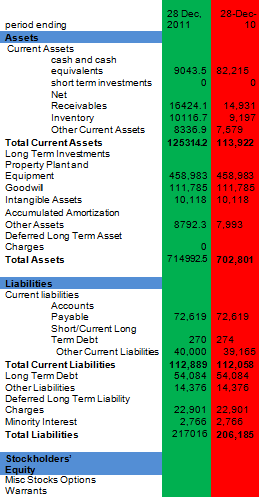

Reference List
Armstrong, M. (2006). A handbook of Human Resource Management Practice. (10th edition). London: Kogan Page.
Bohm, A. (2009). The SWOT Analysis. Muunich: GRIN Verlag.
Griffin, R. W. (2011). Management. Mason, OH: South-Western Cengage Learning.
Hill, T., & Westbrook, R. (1997). SWOT Analysis: It’s Time for a Product Recall. Long Range Planning, 30 (1): 46–52.
Joshi, R. M. (2005). International Marketing. New Delhi and New York: Oxford University Press.
Kern, R. (2001). S.U.R.E.-fire direct response marketing: generating business-to-business sales leads for bottom-line success. New York: McGraw-Hall.
Kotler, P., & Keller, K.L. (2006). Marketing Management. (12th ed). New York: Pearson Prentice Hall.
Porter, M. (1998). Competitive Advantage. (revised ed.). New York: The Free Press.
Schultz, D. E., & Kitchen, P. J. (2000). Communicating Globally. London: Palgrave Macmillan.
Texas Roadhouse. (2011). Texas Roadhouse, Inc: Annual Report 2010. 1-132.
Torlak, N. G., & Sanal, M. (2007). David’s strategy formulation framework in action: The example of Turkish airlines on domestic air transportation. Web.